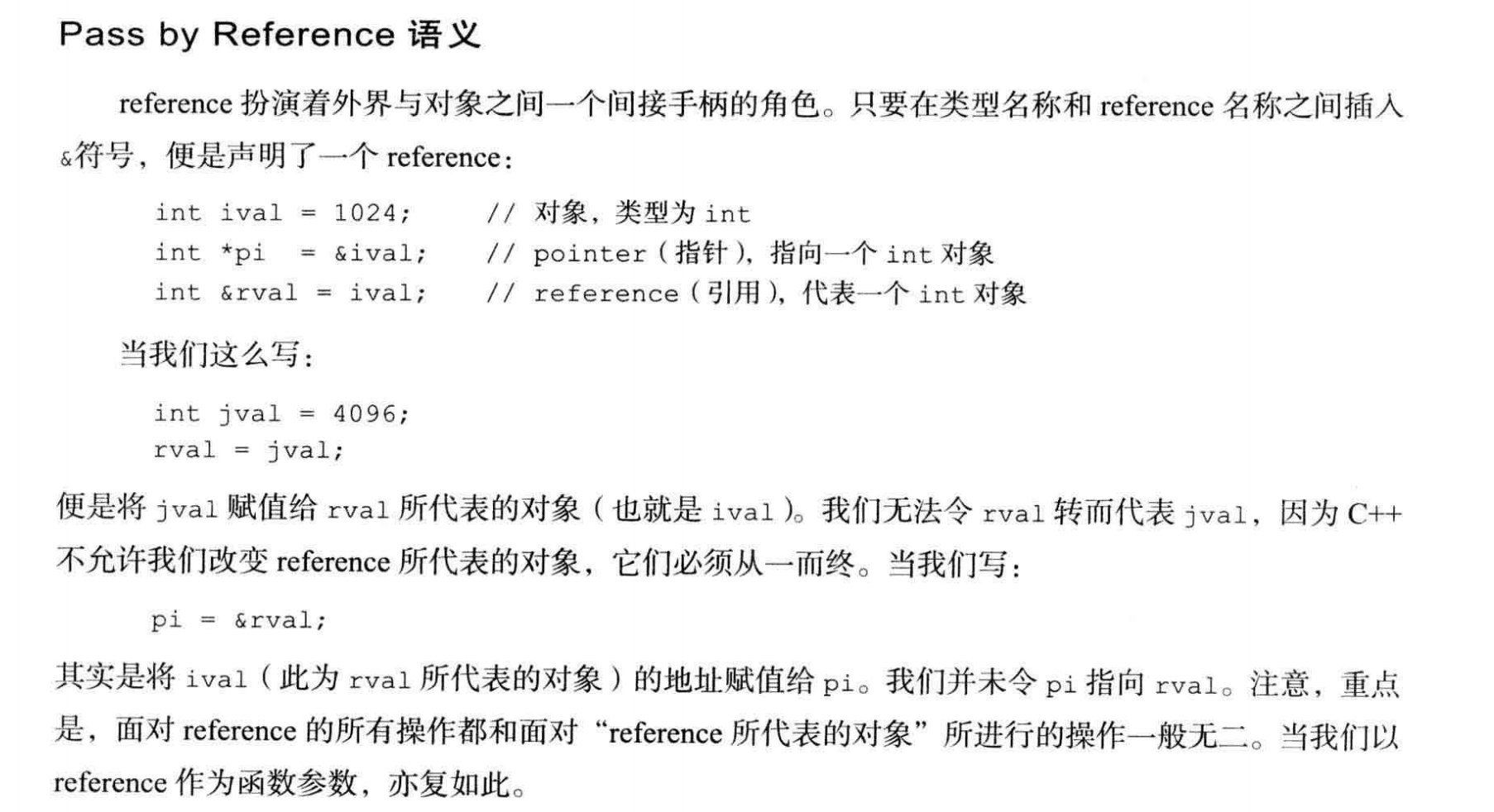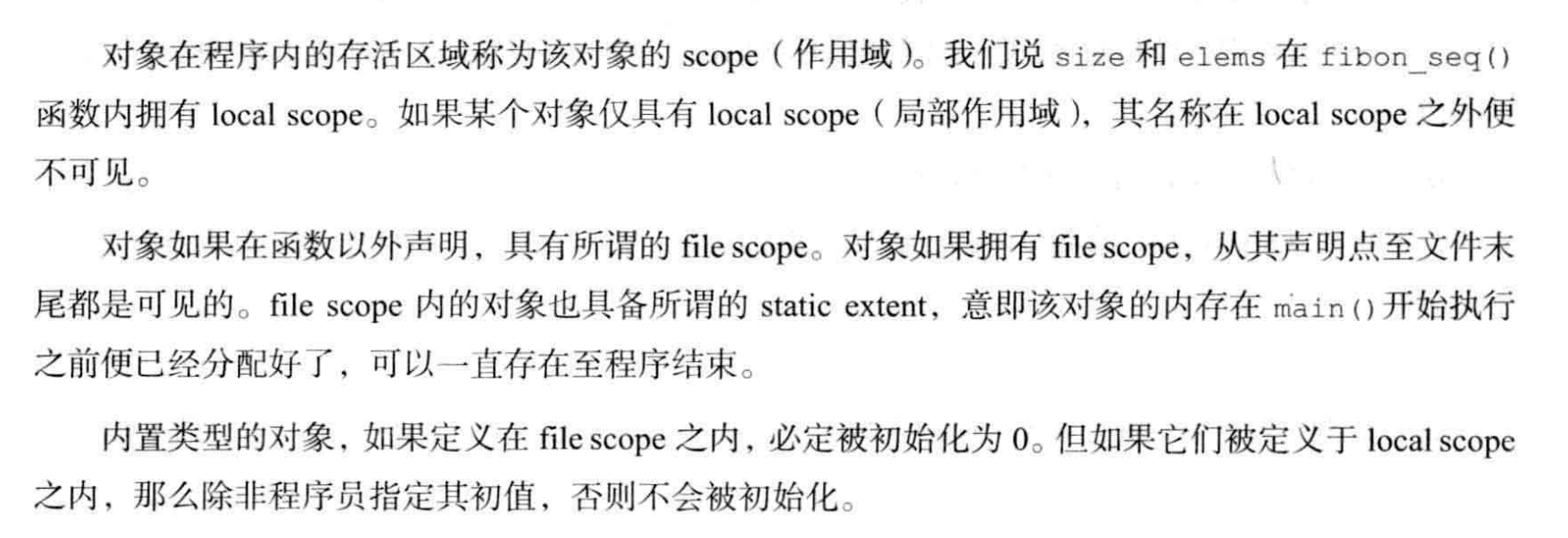第二章 面向过程

传参数 其实除了传递值本身,另外的其实有两种,一种是传递地址(pointer),一种是传递reference
???


inline 性能和可读性
重载机制: 将一组实现代码不同但工作内容相似的函数加以重载,可以让函数用户更容易使用这些函数,如果没有重载机制,就需要为每个函数提供不同的名称
模版函数: 就是一些函数,功能一样,只是参数类型不一样,每一个都重写就很麻烦,模版函数可以实现将参数类型推迟绑定,绑定后生成一份函数实例
模版函数也可以再进行重载
函数指针有点晕,看看c那本书
章节2练习
练习2.1

1
2
3
4
5
6
7
8
9
10
11
12
13
14
15
16
17
18
19
20
21
22
23
24
25
26
27
28
29
30
31
| #include <iostream>
using namespace std;
bool fibon_elem(int,int &);
int main()
{
int pos,elem;
while(1){
cout << "please input a position,exit:-1 ";
cin >> pos;
if (pos == -1) return 0;
if (fibon_elem(pos,elem))
cout << "element # " << pos << " is " << elem <<endl;
else cout << "sorry, could not calculate element # "<< pos <<endl;
}}
bool fibon_elem(int pos,int &elem)
{
if (pos <=0 || pos >1024)
{
elem=0;return false;}
elem =1;
int n_1 = 1,n_2=1;
for (int ix=3;ix<=pos;++ix)
{
elem = n_2+n_1;
n_1 = n_2;
n_2 = elem;
}
return true;
}
|
练习2.2

1
2
3
4
5
6
7
8
9
10
11
12
13
14
15
16
17
18
19
20
21
22
23
24
25
26
27
28
29
30
31
32
33
34
35
36
37
38
39
40
41
42
43
44
45
46
| #include <iostream>
#include <vector>
using namespace std;
void add(vector<int> &vec,int num);
void display(const vector<int> &vec);
int main()
{
vector<int> vec(0);
while(1){
cout << "please input the num you want,exit:-1" << endl;
int num;
cin >> num;
if (num == -1) exit(-1);
add(vec,num);
display(vec);
}
return 0;
}
void add(vector<int> &vec,int num)
{
if (num<=0 || num > 1024)
{
cerr << "warning:num is wrong" << endl;
exit(-1);
}
int pn=0;
for (int ix=vec.size()+1;ix<=num;ix++)
{
pn = (ix*(3*ix - 1))/2;
vec.push_back(pn);
}
}
void display(const vector<int> &vec)
{
for (int ix=0;ix < vec.size(); ++ix)
{
cout << vec[ix] << ' ' ;
}
cout << endl;
}
|
练习2.3

1
2
3
4
5
6
7
8
9
10
11
12
13
14
15
16
17
18
19
20
21
22
23
24
25
26
27
28
29
30
31
32
33
34
35
36
37
38
39
40
41
42
43
44
45
46
47
48
49
50
51
52
| #include <iostream>
#include <vector>
using namespace std;
inline bool is_size_ok(int size);
void add(vector<int> &vec,int size);
void display(const vector<int> &vec);
int main()
{
vector<int> vec(0);
cout << "please input the num you want" << endl;
int size;
cin >> size;
add(vec,size);
display(vec);
return 0;
}
inline bool is_size_ok(int size)
{
const int max_size = 1024;
if(size <=0 || size > max_size)
{
cerr << "warning:num is wrong" << endl;
return false;
}
return true;
}
void add(vector<int> &vec,int size)
{
if (!is_size_ok(size))
exit;
int pn=0;
for (int ix=1;ix<=size;ix++)
{
pn = (ix*(3*ix - 1))/2;
vec.push_back(pn);
}
}
void display(const vector<int> &vec)
{
for (int ix=0;ix < vec.size(); ++ix)
{
cout << vec[ix] << ' ' ;
}
cout << endl;
}
|
答案给的版本翻译过来
1
2
3
4
5
6
7
8
9
10
11
12
13
14
15
16
17
18
19
20
21
22
23
24
25
26
27
28
29
30
31
32
33
34
35
36
37
38
39
40
41
42
43
44
45
46
47
48
49
50
51
52
53
54
55
| #include <iostream>
#include <vector>
using namespace std;
inline bool add(vector<int> &vec,int size);
void display(const vector<int> &vec);
void really_add(vector<int> &vec,int size);
int main()
{
vector<int> vec(0);
cout << "please input the num you want" << endl;
int size;
cin >> size;
if(add(vec,size))
display(vec);
return 0;
}
inline bool add(vector<int> &vec,int size)
{
const int max_size = 1024;
if(size <=0 || size > max_size)
{
cerr << "warning:num is wrong" << endl;
return false;
}
if (vec.size() < size)
really_add(vec,size);
return true;
}
void really_add(vector<int> &vec,int size)
{
int pn=0;
for (int ix=vec.size()+1;ix<=size;ix++)
{
pn = (ix*(3*ix - 1))/2;
vec.push_back(pn);
}
}
void display(const vector<int> &vec)
{
for (int ix=0;ix < vec.size(); ++ix)
{
cout << vec[ix] << ' ' ;
}
cout << endl;
}
|
练习2.4

1
2
3
4
5
6
7
8
9
10
11
12
13
14
15
16
17
18
19
20
21
22
23
24
25
26
27
28
29
30
31
32
33
34
35
36
37
38
39
40
41
42
43
44
45
46
47
48
49
50
51
52
53
54
55
56
57
58
59
60
61
| #include <iostream>
#include <vector>
using namespace std;
void show(int num);
inline bool is_size_ok(int size);
vector<int>* store();
void add(int size);
int main()
{
cout << "please input the size you want" << endl;
int size,num;
cin >> size;
add(size);
cout << "please input the num you want" << endl;
cin >> num;
show(num);
return 0;
}
inline bool is_size_ok(int size)
{
const int max_size = 1024;
if(size <=0 || size > max_size)
{
cerr << "warning:num is wrong" << endl;
return false;
}
return true;
}
vector<int>* store()
{
static vector<int> vecp;
return &vecp;
}
void add(int size)
{
if (!is_size_ok(size))
exit;
vector<int>* vecp= store();
vector<int>& vec = *vecp;
int pn=0;
for (int ix=vec.size();ix<=size;ix++)
{
pn = (ix*(3*ix - 1))/2;
vec.push_back(pn);
}
}
void show(int num)
{
vector<int>* vecp= store();
vector<int>& vec = *vecp;
cout << "this:" <<vec[num]<<endl;
}
|
练习2.5

inline 的话,就不用再声明了?
1
2
3
4
5
6
7
8
9
10
11
12
13
14
15
16
17
18
19
20
21
22
23
24
25
26
27
28
29
30
31
32
33
34
35
36
37
38
39
40
41
42
43
44
45
46
47
48
49
50
51
52
53
54
55
56
57
58
59
60
61
62
63
64
65
66
67
68
69
70
71
72
73
74
75
| #include <string>
#include <iostream>
#include <vector>
#include <algorithm>
using namespace std;
int max(int a,int b);
float max(float a,float b);
string max(string a,string b);
int max(vector<int> &vec);
float max(vector<float> &vec);
string max(vector<string> &vec);
int max(int* a,int size);
float max(float* a,int size);
string max(string* a,int size);
int main()
{
string sarray[] = {"we","were","her","pride","of","ten"};
vector<string> svec(sarray,sarray+6);
int iarray[] = {12,70,2,169,1,5,29};
vector<int> ivec(iarray,iarray+7);
float farray[] = {2.5,24.8,18.7,4.1,23.9};
vector<float> fvec(farray,farray+5);
int imax = max(max(ivec),max(iarray,7));
float fmax = max(max(fvec),max(farray,5));
string smax = max(max(svec),max(sarray,6));
cout << "imax should be 169 -- found: " << imax << '\n'
<< "fmax should be 24.8 -- found: " << fmax << '\n'
<< "smax should be were -- found: " << smax << '\n';
}
int max(int a,int b)
{
return a>b? a:b;
}
float max(float a,float b)
{
return a>b? a:b;
}
string max(string a,string b)
{
return a>b? a:b;
}
int max(vector<int> &vec)
{
return *max_element(vec.begin(),vec.end());
}
float max(vector<float> &vec)
{
return *max_element(vec.begin(),vec.end());
}
string max(vector<string> &vec)
{
return *max_element(vec.begin(),vec.end());
}
int max(int* arr,int size){
return *max_element(arr,arr+size);
}
float max(float* arr,int size){
return *max_element(arr,arr+size);
}
string max(string* arr,int size){
return *max_element(arr,arr+size);
}
|
在写这个程序的时候遇到了很多奇奇怪怪的小问题,都是对很多地方理解不到位,有时间了慢慢总结.
练习2.6

1
2
3
4
5
6
7
8
9
10
11
12
13
14
15
16
17
18
19
20
21
22
23
24
25
26
27
28
29
30
31
32
33
34
35
36
37
38
39
40
41
42
43
44
45
46
| #include <string>
#include <iostream>
#include <vector>
#include <algorithm>
using namespace std;
template <typename Type>
inline Type max1(Type a,Type b)
{
return a>b? a:b;
}
template <typename elemType>
inline elemType max1(const vector<elemType> &vec)
{
return *max_element(vec.begin(),vec.end());
}
template <typename arrayType>
inline arrayType max1(const arrayType *arr,int size)
{
return *max_element(arr,arr+size);
}
int main()
{
string sarray[] = {"we","were","her","pride","of","ten"};
vector<string> svec(sarray,sarray+6);
int iarray[] = {12,70,2,169,1,5,29};
vector<int> ivec(iarray,iarray+7);
float farray[] = {2.5,24.8,18.7,4.1,23.9};
vector<float> fvec(farray,farray+5);
int imax = max1(max1(ivec),max1(iarray,7));
float fmax = max1(max1(fvec),max1(farray,5));
string smax = max1(max1(svec),max1(sarray,6));
cout << "imax should be 169 -- found: " << imax << '\n'
<< "fmax should be 24.8 -- found: " << fmax << '\n'
<< "smax should be were -- found: " << smax << '\n';
}
|
这里出现了一个奇怪的错误,网友也有很多遇到的
1
2
| 1.c:38:41: error: call of overloaded ‘max(int, int)’ is ambiguous
38 | int imax = max(max(ivec),max(iarray,7));
|
https://segmentfault.com/q/1010000019322724
















